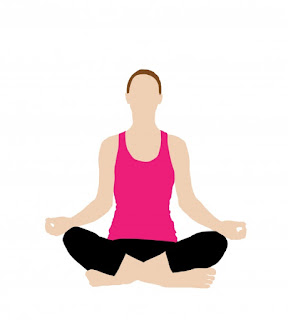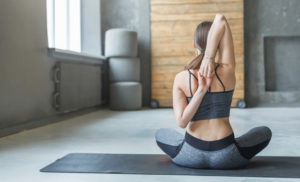The Eight Limbs of Yoga
Yamas
Niyamas
Asana
Pranayama
Pratyahara
Dharana
Dhyana
Samadhi
A Brief History of Yoga
Vedic Yoga
Pre-Classical Yoga
Classical Yoga
Post-Classical Yoga
Modern Yoga
Styles of Yoga
Ashtanga Yoga
Kundalini Yoga
Hatha Yoga
Bikram Yoga
Kriya Yoga
Raja Yoga
Iyengar Yoga
What Yoga Can Bring to Your Life
Increasing Your Sense of Space
Supporting Weight Loss
Adding to Your Strength
Enhancing Flexibility
Improving Balance
Easing Stress
Perfecting Your Posture
Improving Circulation
Enhancing Focus
Assisting with Sleep
Adding to Your Inner Strength
Protecting Yourself from Injury
Improving Athletic Performance
Managing Chronic Conditions
Now that you’vemet me, I think it’s time to meet yoga. What is it? Where did it come from? What are its benefits? Is it a workout, or is it something else?There are many aspects of yoga, and they mightnot all appealto you. However,it helps to understand them in order to find the style of yoga that suits you best. For me, it started as a purely physical practice. Soon, it became a lifestyle. For you, it might be completely different. But that’s the beautyof yoga: You decidehow it should exist in your life. So let’s get down to the basics.What Is Yoga?Yoga isnow. That’s it. That’s all there is to know. Good night and thank you.Okay, it’sfar more than that. But that sentence, Yoga is now, is the whole thing boileddown to three words.The problemis that “now” is a pretty hard concept to put into practice in our daily lives. Have you ever tried to live in the moment, right here, right now, with no distractions and no other thoughts in your head? It’s difficult. That’s why a man named Patanjali, who lived during the second century BC, wrote the Yoga Sutrasas a guideto yoga. “Yoga is now” is the first of his 196 sutras.But it’s only the beginningof his teachings.Patanjali, who is considered to be the founder of the philosophy of yoga, defines yoga as the ability to cease identification with the movements of the mind—in other words, to “live in the now.” Theliteral translation of yoga is “to yoke” or “union” or “to join.” Modernyogis translate this as the union of the mind and the body. This is why when most of us think of yoga, we think of Down Dog or fancy balancing poses. Much of the work thatwe do in the physicalpractice of yoga is meant to carry over into our mentalstates.For example, if we hold a pose and work through some discomfort in our thighs or our arms, then we learn to understand that when we are faced with the pain that comes from the difficult times in our lives, we have the strength to get through it. The physical helps the mental and vice versa; therefore, one cannot exist without the other, and that is why wehave yoga—or the union of the two.The Eight Limbs of YogaPatanjali understood that there was more to yoga than just moving the body. Achieving the now is hard work. Using the lessons of his Sutras, he broke yoga down into the following eight areas or “limbs,” known as ashtanga.YAMASself-controlNIYAMASmethods of disciplineASANASphysical posturesPRANAYAMAbreath workPRATYAHARAassistance with withdrawing from the sensesDHARANAconcentrationDHYANAmeditationSAMADHIabsorption or liberation from the mind and the bodyAs you can see, yoga is more than just a kickass workout. Asanas—the physical postures—are just one partof the yoga practice. In order to comprehend yoga as a whole, we need to understand all eight of these principles.I recognize that for now theseSanskrit terms probably mean nothing to you, and you might just want to move on to the poses. That’s perfectly fine.However, if you begin to prac- tice yoga in a yogastudio or startto follow videos online,it is inevitable thatsome of theseSanskrit words will comeup in one or more of your classes. Thatis why I mention themhere, so they willreveal themselves in ways that helpyou.Besides asana, the most referenced of the branches of ashtanga arethe first two principles: the yamas and niyamas. Patanjali breaks down each of these into five differentareas, which are described below.YamasThe yamas describe ways in which we can control our actions and our reactions. The five yamas areas follows:1. Ahimsa2. Satya3. Asteya4. Brahmacharya5. AparigrahaAHIMSAAhimsa literally translates to “not injury.”The easiest way to think about it is like the doctor’s Hippocratic oath, which says, “First, do no harm.” It is the guiding principle that physicians use in making any major medicaldecision.According to ahimsa, it should guide yoga practice as well.This principle can be as simple as the lessons taught to kids, such as do not hit and do not fight, or it can get more complex in the form of exercising restraint. Examples of this are not talking ill of others or trying not to harbor hatred of those who have done wrong. But ahimsa doesn’t solelyapply to how to treat others. It applies to how you treat your own body as well. In a sense,it asks you to be your own doctor.Ahimsa encourages you to consider the following issues:✦ Preventing injury or sickness✦ Learning to rest when you’ve overdoneit✦ Finding ways to cope with stress at work or home Some yogis also translate ahimsa tobeing vegan and notharming animals. This worksgreat for some,but not forall. Deciding what it means to do no harm to your body can be a personal matter.SATYASatya is the practice of honesty—not only with others but also with yourself. Being truthful is one of the biggest les- sons that you can translate to the yoga mat. Once you start to learn the poses, how can you be honest with yourself? How can you listen to your body and understand when you’ve pushed it too far or not far enough?Practicing satya can help youfeel better about yourself.ASTEYAAsteya isthe practice of not stealing. It can also mean not coveting the things thatbelong to others,whether they are material or intangible. It’sthe practice of letting go of jealous feelings and ceasing to compare yourselfwith others.BRAHMACHARYABrahmacharya isperhaps the mostinteresting yama.It has beentranslated to mean abstinence, and Patanjali did believe in celibacy. However, in today’s modern world that might not be possible, so we translate this one to mean “notspend- ing your time on thingsthat waste your energy.”There are plenty of examples of this. Perhapsyou’re always sayingyes to every inviteyou get and you’re exhausted. Maybe you’re holding on to relationships that no longerserve you or the other person. Brahmacharya urges you to ridyour life of the things that drain you.APARIGRAHAAparigraha means “nongreed.” This yama encourages you to stop living in excess. Have you ever had thoughts like, “If I had more money,or a bigger house, or better clothes, I would be happy”?Aparigraha encourages you to let go of those thoughts and be content with what you do have. To live by the principle of Aparigraha, do your best to derive happiness from yourself and the love around you rather than preferring thingsthat you can buy or obtain.NiyamasThe niyamas consist of the following:✦ Saucha✦ Santosha✦ Tapas✦ Svadhyaya✦ Isvara PranidhanaThese five concepts lay out ways to act in the world. They encourage you to contemplate how you act as an individual, consistently.SAUCHASaucha means “cleanliness.” This can mean everything from keeping the house clean to eating pure and good foods to freeing your life of things that do not serve you. It’s a simple concept and one that can relateto just about every aspectof your life.SANTOSHATranslated as “contentment,” santosha is all about being happy with where you are right now. It’s still fine to have goals, but even as you strive for them, be content with what you have in the moment. Have aim and intention, but don’t be fixated on the outcome.TAPASTapas means “working through the difficult things in life in order to create change.”Sometimes in class teachers will talk about building tapas, which can mean “heat.”This heat is meantto create a literal change—perhaps by making you more flexible or stronger or leaner. In the general sense, however, it is about working through problems and find- ing solutions. You know that saying, “What doesn’t kill you makes you stronger”? Well, whoever came up with it might have read a little bit about tapas.SVADHYAYASvadhyaya isthe act of self-study. It asks you to becomeyour own keeper. Through self-study you begin to learn which tapas are good for you, which pain is going to help you grow,and whichpain takes you away fromthe practice of ahimsa and causes harm.Svadhyaya concerns taking responsibility foryour life and contemplating what you need to grow.ISVARA PRANIDHANAIsvara pranidhana acknowledges that something “out there” is bigger than humanity as a whole. This principle empha- sizes that individuals have no real control over anything, regardless of their belief systems.AsanaAsana is the physical practice of yoga.These are the poses, the Down Dogs and the Up Dogs, and all the stretching and balancing in between. Later,as you learn more about the physical practice, asanawill help you grasp the other aspects of yoga.PranayamaPranayama is breath work. There are many types of yogic breathing out there, but one of the simplest is learning to breathe slowly and deeply. It is said that most people use only a small portion of their lungs’ capacity to breathe. Mak- ing a conscious effort to fill your lungs with air can create a calming effect that relieves stress.PratyaharaPratyahara isthe practice of withdrawing fromthe senses in order to focus in on yourown thoughts, by being ableto look inward. It’s like sitting at your desk to work and turning off your phone and the Internet so that you don’t get distracted.DharanaDharana is the ability to concentrate on one thing and let all else drift away. Think about a professional athlete, the golfer making that winning putt or the football player running that last touchdown. He or she is so focused on the task ahead that everything else disappears. This ability to concentrate intently leads to taking the next step—meditation.DhyanaDhyana isthe practice of meditation. I have a teacher who describes meditation as beingable to tune everything else out and focus on one thing.She prompts studentsto focus solely on their breathand when theirminds start to wander to come back to the breath. Thisis the simplestway to medi- tate as discussed laterin this book.SamadhiSamadhi is the highest point of yoga. It’s that perfect bal- ance where the mind is calm and the body is in a state of internal stability. It is whatall the otherprinciples of yogaare designed to helpus achieve. It is theultimate “now.”A Brief History of YogaWe’ve touchedon some of the historyof yoga with Patanjali’s sutras and the eight principles, but there is still so much to be known. How did this thing we call yoga come to be?The history of yoga can be broken down into five periods:1. Vedic2. Pre-Classical3. Classical4. Post-Classical5. ModernVedic YogaTheVedic period of yoga spans the time of 500 to 1000 BC. It is during this period that the Rig Vedas were written. These books of hymnsare the oldest known scriptures in existence, and they contain the early beginnings of yoga. Rather than emphasizing the postures, the Rig Vedas sought to join the material and spiritual worlds. Everything was based on the spiritual, and Vedic yogis were adept at focusing their minds for long periods of time. This focus produced visions that allowed the yogis to see the root of their very existence.Pre-Classical YogaThe Pre-Classical period of yoga is marked by the publica- tion of the Upanishads, which arrived somewhere between the fifth and seventeenth centuries BC. The Upanishads not only furthered the knowledge of the Rig Vedas, but also broke them down to explain the ultimate reality and the transcendental self.These became guidesto explain how toapply the knowledge of the Rig Vedas to your daily life. Later during this period, the Bhagavad Gita was written. This text is the firstbook to be devoted entirelyto yoga. It tells thestory of the god Krishna and the soliderArdjuna. This parable introduces the idea of disassociating with the ego to avoid difficulties or pain. Today, many yogis reference this text to explain the letting go of the ego.Classical YogaThis period centers around Patanjali’s Yoga Sutras and the eight principles of yoga, which were discussed earlier in this chapter. This period produced the idea that the mind and body were separate and they must be worked on separately via meditation and asana.Post-Classical YogaDuring the Post-Classical period, yogi masters began to focus on thestrengths and abilities of the body.They created a systemof physical posturesthat would challenge the body and help prolong its life. This system of postures became Hatha yoga and is the beginning of the asanapractice that we know today. It is here that yogis wrapped their minds around the concept of living in the moment.The purpose of thepostures was to facilitate concentration and meditation to reachthe state of samadhi, which is the highest mental state of yoga.Modern YogaIn 1893, Swami Vivekananda came over from India to address the Parliament of Religions held in Chicago.It was there that yoga was first introduced to the American public and the Modern period of yoga began.The Modern period emphasizes the asanas and efforts toward uniting the mind and the body. It draws from every previous period, focusing on works such as the Bhagavad Gita and Patanjali’s Yoga Sutras. Today, teachersfrom all over the world work to spread the knowledge of yoga, and there are many different styles in existence.Styles of YogaWhile these styles of yoga allstem from thesame historical roots, theyare distinct in their focusand beliefs. Hereare seven of the most popularstyles:✦ Ashtanga✦ Kundalini✦ Hatha✦ Bikram✦ Kriya✦ Raja✦ IyengarAshtanga YogaNot to be confused with Patanjali’s eight-limbed path to yoga, Ashtanga Yoga is a system of yoga created by Sri K. Pattabhi Jois. It is known to be one of the most physically challenging versions of yoga. These series are to be prac- ticed six days a week,except for moon days—days of the new and full moon—during which the practitioner will rest. The Ashtanga style is usually a self-practice. It is done under the Mysore style, which requires a teacher to assist the student into poses. Students discover when they are ready to move on to the next series, much like achieving different belts in karate. Ashtanga consists of six series, and very few people have made it to the final one.Kundalini YogaKundalini was brought to the United States in 1968 by Yogi Bhajan. It’s called the yoga of awareness and is considered the most spiritual practice that exists today. Kundalini refers to the energy that lies dormantat the base of the spine. Prac- ticing meditation, breath work, mantra, dance, and asana raises this energyup the spine and out through the chakras. (A mantra is a chant that supports meditation. A chakra is a point of energy in the human body.) The goal of Kundalini is tocreate a senseof well-being and heightened awareness.Hatha YogaHatha is the most widely practiced form of yoga, combin- ing movement with conscious breathing. This system was developed by Yogi Swatmarama to develop strengthand flex- ibility using a set of physicalpostures. These poses are meant toalign the skin, muscles, and bones of the body.Bikram YogaCreated by Bikram Choudhury, Bikram Yoga is a set sequence of 26 posturesand two breathingexercises. It is meantto restore the body to its properworking order,creating a sense of good health,proper weight, muscle tone, and flexibility. Bikram Yoga is practiced under a strict set of guidelines, which includes a room heated to 105 degrees with 40 percent humidity. Only teachers who have trained under Bikramcan teach the Bikram method.Kriya YogaKriya yoga is an ancient system brought to the West by Paramahansa Yogananda. Kriya is a system of meditation using breath, concentration, and a meditation technique meant to accelerate one’s spiritual growth. It focuses on controlling the breath.Raja YogaRajayoga is sometimes referred to as Royal yoga.It is known as the yoga of the mind. The premise of the practiceis this: The mindcontrols the world.Controlling the mind makes it possible to control the world aroundus. The biggestpart of the practice is meditation. Other techniques are included, such as asana andbreath work. Theseare meant to teach practitioners to calm their minds and bring them to one point of focus.Iyengar YogaIyengar is based on the eight limbs of yoga describedin Patanjali’s Yoga Sutras. Founded by BKS Iyengar in 1937,Iyengar is a system of postures that focuses on alignment and breath control. It is a form of Hatha yoga that is char- acterized by its great attention to detail. Iyengar was one of the first teachers to use props in order to make yoga more accessible to everyone—beginners, advanced, seniors, those whoare ill, and all others.What Yoga Can Bring to Your LifeAccording to the latestYoga in America studyconducted by Sports MarketingSurveys USA on behalf of Yoga Journalin 2012, there are 20.4 million Americans who practice yoga, and 44.8 percent of them consider themselves to be begin- ners. When asked in the surveywhy people are doing yoga, the top five reasonsfor starting were as follows:1. Flexibility (78.3 percent)2. General conditioning (62.2 percent)3. Stress relief (59.6 percent)4. To improve overall health (58.5 percent)5. Physical fitness (55.1 percent)I can tell you from my own experience that all fiveof these reasons areexcellent and validreasons to cometo yoga. However, there is far more to be gained from yoga thanstrength, flexibility, good health, and less stress.As one of thefew forms of exercise thatalso focuses on themental aspect of health, yoga’slist of benefits is quite long. The following sectionsoffer you a small samplingofwhatyou can expectwhen you startto practice, but don’t be surprised if you noticeother changes happening as well.Increasing Your Sense of SpaceProprioception is the ability to understand how your body moves in space. It’sme standing at the frontof the room askingyou to stepyour right footforward and point your toes straight ahead. You do this without having to look down.By focusing on alignment in the poses,yogis’ proprioception increases.Supporting Weight LossAsa system of exercise that can increaseyour heart rate and build muscle, yoga inevitably makesweight loss possible. But one of the other benefits of yoga is that many people begin to eat more mindfully. Because they start to feel better over- all, they start to make healthier choices for their bodies.Adding to Your StrengthTheposes require you to hold your own body weightin a variety of ways. Thisstresses your musclesin a manner that encourages them to get stronger, much like liftingweights.Enhancing FlexibilityThis is the obvious benefit that comes to mind when you think of yoga. Stick with the practice. You’ll find that your joints become more mobile and you wake with less stiffness.Improving BalanceMany poses in the practice work on balance, but one of the major components of every pose is engagingthe core mus- cles. Doing so teachesyou to center your body and achieve physical balance with ease.This balance sometimes starts to transfer into our daily lives as well. So, you might also create abetter work-life balance,too.Easing StressYoga gives you the tools to relax, either through asana, breath work, or meditation. Breathing in a deep mindful manner calms the nervous system. The physical practice produces endorphins, and meditation brings clarity. (Endor- phins are hormones that produce a feeling of well-being.)Perfecting Your PostureYoga strengthens the muscles of the core (generally, the abdomen and lower back), which causes your body to seek out a more proper upright position. It also keeps the spine supple and its surrounding muscles flexible.Improving CirculationYoga hasmany proven benefitsfor the heart,including lowering blood pressureand lowering heartrate. Also, the movement associated with yogaencourages the body’s lymph fluid to drainmore properly. Lymphcontains the white blood cells in the humanimmune system.Enhancing FocusOneof the goals of yoga is to concentrate on the breathand the alignment of the postures. Doing so clears the mind of extraneous thoughts. By training the brain to focus like this on the mat, you are able to focus in your daily life.Assisting with SleepClearly, you expend energy when you move your body and are therefore more tired at the end of the day. But because yoga also works on easing stress and creating focus, it becomes easier to slip off into slumber at night.Adding to Your Inner StrengthAs your body gets stronger and more flexible, you tend to gain a confidence that you might not have had previously. Through tapas (the heat you create to initiate change), you might find that experiences in your life improve without you having made a conscious effort.Protecting Yourself from InjuryBecause the asana practiceof yoga focuseson strength and flexibility, many people will find that their bodies become stronger and moreresistant to injurythan they wereprior to beginning yoga.Improving Athletic PerformanceYoga strengthens the body and makes athletes agile and strong. It also brings a new sense of clarity or focus to athletes that they can use to improve their performances.If you name a sport, I guarantee you can find someone who has created a system of yoga poses that will produce sport- specific results and prevent common injuries.Managing Chronic ConditionsMany different types of yoga have sprung up to help people deal with specific needs. There is pre-and post- natal yoga that helps expectant and new mothersadapt to the changes in their bodies. Yoga for the aging can help keep seniors active and free from injury.Yoga practice can also benefitthose managing diseases such as diabetes or multiple sclerosis.Regardless of your physicalcapabilities, if you have a desireto practice yoga, there is a way to do it. It’s simply a matter of sorting through your options and finding apractice that works best for you to create the greatestarray of benefits. Read More
Read More









